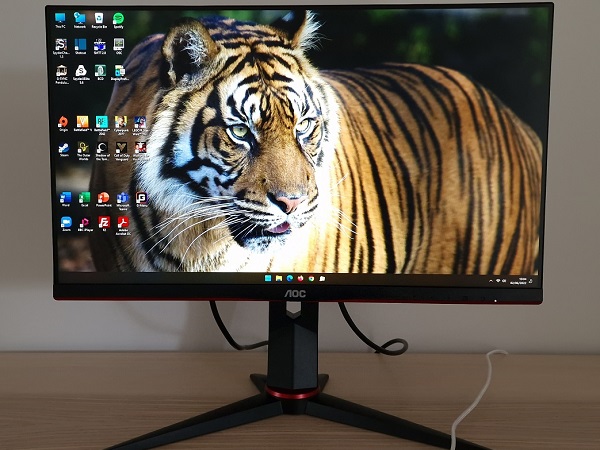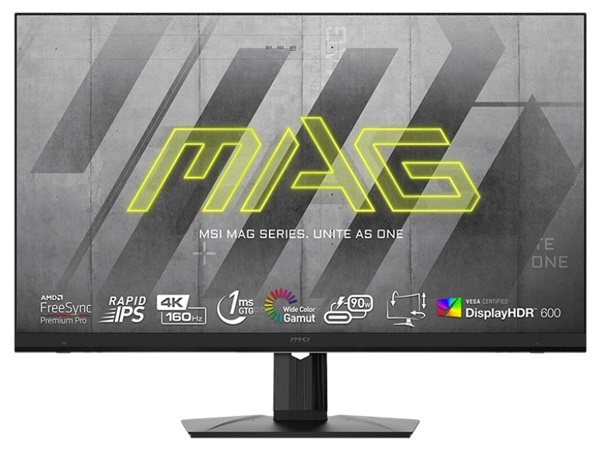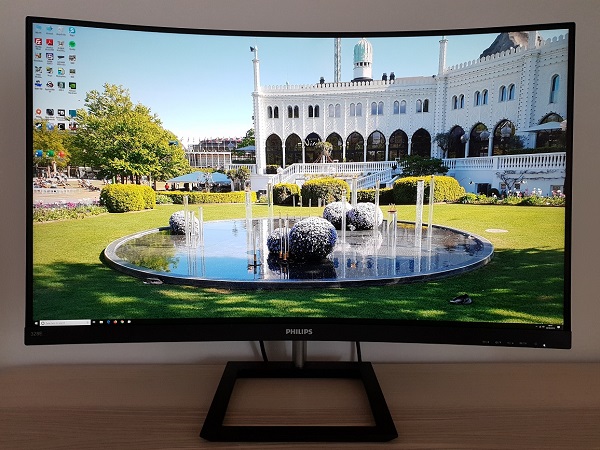Author: Adam Simmons
Last updated: June 15th 2024
Our key up to date recommendations are given in the table below, grouped by size.
As an Amazon Associate and Newegg Affiliate I earn from qualifying purchases made using “Buy” buttons on this page. Where possible, you’ll be redirected to your nearest store. Further information on supporting our work.
KOORUI GP01 (23.8″ 165Hz IPS, 2560 x 1440)

KOORUI GP01
- 23.8″ IPS panel (BOE MV238QHM-NF0 IPS-ADS)
- 2560 x 1440 (QHD or 1440p)
- 165Hz (48 – 165Hz VRR, FreeSync + G-SYNC Compatible), 180Hz OC
- 120Hz 1440p support for the PS5
- 120Hz 1080p support for the Xbox Series X/S and PS5
- 1ms grey to grey response time
- Basic HDR10 support
Additional points:
- Light matte anti-glare screen surface
- PWM-free (flicker-free) WLED backlight
- ~sRGB colour gamut and 350 cd/m² (354 cd/m² measured) peak luminance
- 2 HDMI 2.0 ports, DP 1.4, 3.5mm headphone jack
- Screen is fully adjustable with 100 x 100mm VESA support
Why choose this monitor:
The KOORUI GP01 provides a rare combination with its 23.8″ 165Hz QHD panel. This provides a high pixel density which aids clarity and maximises the ‘desktop real estate’ offered by the screen. Combined with an IPS-type panel, the monitor is well-suited to a range of uses including gaming and general desktop usage. The native gamut extends just slightly beyond sRGB for a ‘rich and natural’ look. It also improves ‘out of the box’ suitability for colour accurate work within the sRGB colour space as well, compared to wide gamut options. As usual best results come from full calibration, however. The screen surface offers decent glare-handling without obvious layering or strong graininess. The fast pixel responses and exceptionally low input lag provides a good 165Hz experience, with VRR support via Adaptive-Sync (AMD FreeSync Premium and ‘G-SYNC Compatible’) sweetening the deal. Maximum brightness is quite good (354 cd/m² maximum measured) and the minimum (96 cd/m² maximum measured) is a bit on the high side but still suitable for most users. The screen is flicker-free and provides a Low Blue Light (LBL) settings to potentially improve viewing comfort, whilst the stand is fully adjustable.
If this model’s not available in your region or priced above it, consider the AOC Q24G2A/BK.
Further reading:
AOC 24G2SP/24G2SPU (23.8″ 165Hz IPS, 1920 x 1080)

AOC 24G2SP(U)
- 23.8″ IPS panel (TPV TPM238WF1-LF4F Panda IPS)
- 1920 x 1080 (Full HD or 1080p)
- 165Hz (48 – 165Hz VRR, FreeSync Premium + G-SYNC Compatible)
- 120Hz support for the Xbox Series X/S and PS5
- 4ms grey to grey response time
Additional points:
- Medium matte anti-glare screen surface
- PWM-free (flicker-free) WLED backlight
- ~92% DCI-P3 colour gamut and 300 cd/m² peak luminance (422 cd/m² measured)
- 2 HDMI 2.0 ports, DP 1.2a, VGA, 3.5mm audio line-in, 3.5mm headphone jack
- ‘SPU’ model includes 4 USB 3.2 Gen 1 ports (plus upstream) and 2 x 2W speakers
- Screen is fully adjustable with 100mm VESA support
Why choose this monitor:
The AOC 24G2SP(U)‘s IPS-type panel provides strong colour-consistency, meaning richness is well maintained throughout the screen. This can be attractive for gaming and also the desktop, whilst making the monitor more suitable for colour-accurate work once fully calibrated. The extended but not extreme colour gamut provides a good dose of extra vibrancy without oversaturation being as strong as some wide gamut models, whilst the monitor shows strong contrast for the panel type. The screen surface provides good glare-handling characteristics without an obviously grainy appearance. With its 165Hz refresh rate, VRR support, low input lag and decent pixel responsiveness it can also hold its own when gaming. The monitor provides a good level of brightness (422 cd/m² maximum measured), whilst the minimum brightness (108 cd/m² maximum measured) will be suitable for most but not all users. Effective Low Blue Light (LBL) settings are also included and the screen is flicker-free, promoting greater viewing comfort. To round things off, the stand is fully adjustable for extra flexibility.
Further reading:
A comparison with the BenQ EX2510(S) and Acer XB253Q GP
ViewSonic VX2728J-2K (27″ 165Hz+ IPS, 2560 x 1440)

ViewSonic VX2728J-2K
- 27″ IPS panel (BOE ME270QHB-NF0 IPS-ADS)
- 2560 x 1440 (QHD or 1440p)
- 165Hz (48 – 165Hz VRR, FreeSync + G-SYNC Compatible), 180Hz OC
- 120Hz 1440p support for the Xbox Series X/S and PS5
- 120Hz 1080p support for the Xbox Series X/S and PS5
- 2.5ms grey to grey response time
- Basic HDR10 support
- 2 x 2W speakers
Additional points:
- Medium or ‘relatively light’ matte anti-glare screen surface
- PWM-free (flicker-free) WLED backlight
- ~95% DCI-P3 (measured) and 250 cd/m² (293 cd/m² measured) peak luminance
- 2 HDMI 2.0 ports, DP 1.4, 3.5mm headphone jack
- Screen is fully adjustable with 100 x 100mm VESA support
Why choose this monitor:
The ViewSonic VX2728J-2K‘s IPS-type panel with QHD resolution provides good detail and clarity levels to games and media content of suitable resolution, whilst providing a good level of ‘desktop real estate’. With fairly generous DCI-P3 gamut things appear vibrant (but not extremely oversaturated), with the strong consistency of the IPS-type panel providing strengths regardless of use and ensuring superior post-calibration accuracy. The contrast performance is close to specified – not really a strength of any IPS monitor, a touch stronger than some but weaker than others sharing this panel type. The screen surface provides good glare-handling characteristics without an obviously grainy appearance. The 165Hz refresh rate (180Hz) OC, VRR capability with ‘single overdrive mode experience’ and exceptionally low input lag make it a good candidate for gaming and provide good fluidity on the desktop as well. Brightness is sufficient for most with a decent adjustment range (63 – 293 cd/m² measured), whilst the flicker-free backlight and LBL (Low Blue Light) settings promote enhanced viewing comfort. The stand offers full ergonomic flexibility, whilst basic HDR10 support is included for extra variety.
Further reading:
MSI MPG 274URF QD (27″ 160Hz IPS, 3840 x 2160)

MSI MPG 274URF QD
- 27″ IPS panel (AUO M270QAN07.0 AHVA)
- 3840 x 2160 (‘4K’ UHD)
- 160Hz (48 – 160Hz VRR, FreeSync + G-SYNC Compatible + HDMI 2.1 VRR)
- 120Hz at up to ‘4K’ UHD for the Xbox Series X and PS5
- 0.5ms grey to grey response time
- VESA DisplayHDR 400
Additional points:
- Light matte anti-glare screen surface
- PWM-free (flicker-free) QD-LED backlight
- 97%+ DCI-P3, 97%+ Adobe RGB colour gamut and 400 cd/m²+ (506 cd/m² measured) peak luminance
- ~500 cd/m² HDR peak luminance
- 2 HDMI 2.1 ports, DP 1.4 (with DSC), USB-C (65W PD, DP Alt Mode, upstream data), 2 USB 2.0 ports (plus Type-B upstream), 3.5mm headphone jack
- Fully adjustable stand. 100 x 100mm VESA mounting supported
Why choose this monitor:
The MSI MPG 274URF QD has a 27″ IPS-type panel with 3840 x 2160 (‘4K’ UHD) resolution, providing exceptional detail and clarity to text and high resolution image and game content plus excellent ‘desktop real estate’ potential. The IPS-type panel ensures strong consistency, attractive for a range of tasks from gaming to image editing, with a true wide gamut providing strong vibrancy and excellent colour accuracy potential. Effective colour space emulation modes are included to clamp the gamut to sRGB, Adobe RGB or DCI-P3. Contrast is typical for the panel type, whilst the light matte screen surface helps preserve vibrancy and clarity with reasonable glare handling on top. The 160Hz refresh rate and well-tuned pixel responses are combined with low input lag and diverse VRR support for a pleasing gaming performance and nice general fluidity. Variable overdrive ensures a single overdrive mode experience with low overshoot throughout the VRR range. The screen provides an exceptional brightness adjustment range, topping out for SDR ~506 cd/m² and going down to ~39 cd/m². Basic HDR10 support at the VESA DisplayHDR 400 is included, whilst the monitor includes a flicker-free backlight and various Low Blue Light (LBL) settings to promote a more relaxing viewing experience. The monitor is fully adjustable with USB-C (65W PD), KVM support and HDMI 2.1 to connect to a broad range of devices.
Prefer higher HDR brightness and not so fussed about such a wide gamut? Consider the Gigabyte M27U.
Further reading:
MSI MAG 323UPF (32″ 160Hz IPS, 3840 x 2160)

MSI MAG 323UPF
- 32″ IPS panel (AUO AHVA)
- 3840 x 2160 (‘4K’ UHD)
- 160Hz (48 – 160Hz VRR, FreeSync Premium Pro + G-SYNC Compatible + HDMI 2.1 VRR)
- 120Hz at up to ‘4K’ UHD for the Xbox Series X and PS5
- 1ms grey to grey response time
- VESA DisplayHDR 600
Additional points:
- Light to very light matte anti-glare screen surface
- PWM-free (flicker-free) WLED backlight
- ~95% DCI-P3 colour gamut and 440 cd/m² (SDR) peak luminance
- 600 cd/m²+ HDR peak luminance
- 2 HDMI 2.1 ports, DP 1.4 (with DSC), USB-C (90W PD, DP Alt Mode, upstream data), 3 USB 2.0 ports (plus Type-B upstream), 3.5mm headphone jack
- Tilt, swivel and height adjustment. 100 x 100mm VESA mounting supported
Why choose this monitor:
The MSI MAG 323UPF features a 32″ IPS-type panel with 3840 x 2160 (‘4K’ UHD) resolution. This provides an immersive experience with strong pixel density that delivers excellent ‘desktop real estate’ plus plenty of detail and clarity to text and suitably high resolution image and game content. Strong colour consistency from the IPS-type panel broadens its appeal for image editing and ensures richness is maintained well throughout the screen. A generous but not extreme colour gamut gives a good hit of extra vibrancy and saturation, but not an extreme amount. An effective sRGB emulation setting is also included to for a more ‘as the developers intend’ look, alongside superior sRGB colour accuracy. Contrast is quite typical for an IPS model, whilst a ‘light to very light’ matte screen surface helps preserve vibrancy and clarity with decent glare handling and a relatively low level of graininess. A 160Hz refresh rate, well-tuned pixel overdrive, low input lag and diverse VRR support helps ensure a superior gaming experience and provides extra fluidity on the desktop. This model provides a decent maximum SDR brightness (~468 cd/m² reliably recorded) but also a quite high minimum brightness (~130 cd/m² reliably recorded). Slightly enhanced HDR support is included at the DisplayHDR 600 level for extra visual variety and a bit of a boost in brightness (~700 cd/m² reliably recorded). The monitor uses a flicker-free backlight with less energetic blue peak (‘Low Blue Light Hardware Solution’ certified by TÜV Rheinland) to promote greater viewing comfort. Additional Low Blue Light (LBL) settings to promote a more relaxing viewing experience, whilst good ergonomic flexibility is offered in addition to USB-C (90W PD) and HDMI 2.1 for enhanced connectivity.
If you require lower minimum brightness (~52 cd/m² rather than ~130 cd/m²), consider the Gigabyte M32U.
Further reading:
Philips 328E1CA (31.5″ 60Hz curved VA, 3840 x 2160)

Philips 328E1CA
- 31.5″ VA panel (TPV TPM315WR1-FP01.S Samsung SVA or similar)
- 1500R curve
- 3840 x 2160 (‘4K’ UHD)
- 60Hz (48 – 60Hz VRR, FreeSync + G-SYNC Compatible)
- 60Hz ‘4K’ UHD for the Xbox Series X and PS5
- 4ms grey to grey response time
Additional points:
- Light matte anti-glare screen surface
- PWM-free (flicker-free) WLED backlight
- ~122% sRGB colour gamut and 250 cd/m² peak luminance (>300 cd/m² measured)
- 2 HDMI 2.0 ports, DP 1.2a, 3.5mm audio input, 3.5mm audio output
- Screen is tilt-only with 100 x 100mm VESA mounting supported
- 2 x 3W speakers
Why choose this monitor:
The Philips 328E1CA provides an immersive and pixel-dense experience with its curved 31.5″ VA panel and 3840 x 2160 (‘4K’ UHD) resolution. We found the curve easy to adapt to, drawing into the image a bit without feeling unnatural. Something that is certainly exaggerated in photos and videos of the screen. The strong pixel density invites good clarity and detail levels, with an excellent amount of useful desktop space for work. As a VA model contrast is a key strength, helping provide a deeper look to darker and even medium shades – something that can be appreciated for a range of tasks. On the colour reproduction side consistency sits between typical IPS and TN models, but is better than some other VA offerings. The gamut extends a bit beyond sRGB without being wide gamut in the traditional sense – a bit of extra vibrancy, but nothing dramatic. The light matte screen surface delivers respectable glare handling without being too obtrusive in terms of graininess or layering in front of the image. The monitor is limited to 60Hz, but offers a decent level of pixel responsiveness for the panel type and couples this with low input lag and VRR support. Brightness adjustment range is reasonable (~80 – 318 cd/m² measured), the backlight is flicker-free and Low Blue Light (LBL) settings are included to promote a potentially more relaxing viewing experience. Ergonomics are limited due to the tilt-only stand, though 100 x 100mm VESA holes are included to facilitate alternative mounting.
Further reading:
A post summarising our thoughts on this model in the context of some alternatives
This list is heavily condensed; look out for the recommended or approved badge in our reviews as well. You can sort our reviews by badge status and various other features there.
These models have been selected for their strong all-round performance and attractive pricing within their segment. Uses can include gaming and other entertainment purposes as well as general desktop usage. Most of these models feature higher than 60Hz (e.g. 144Hz+) refresh rates which provides an edge in visual and felt fluidity whether gaming or on the desktop. Other attractive features such as viewing comfort and ergonomics are also considered, with many models here featuring IPS-type panels which are well suited to colour accurate work as well.
Confused about the terminology? Check out one of our dedicated guides on the topic.
